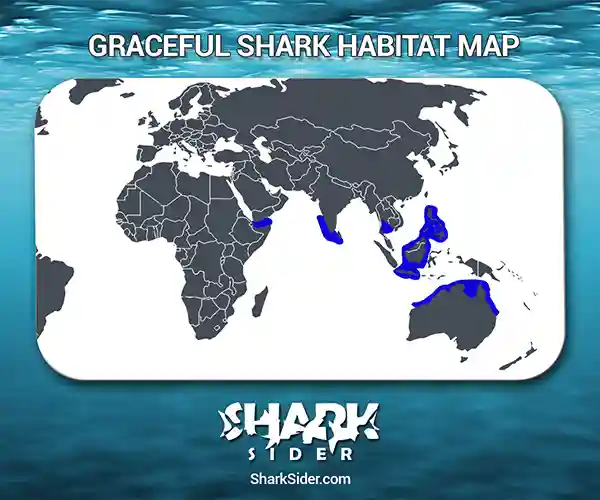The graceful shark, or Queensland shark as it is sometimes called, is a species of requiem shark living in the Indo-Pacific.
Graceful Shark Scientific Classification |
|
| Kingdom | Animalia |
| Phylum | Chordata |
| Class | Chondrichthyes |
| Order | Carcharhiniformes |
| Family | Carcharhinidae |
| Genus | Carcharhinus |
| Scientific Name | C. amblyrhynchoides |
Description
Graceful sharks can reach a maximum length of 5.6 ft. Despite its name, this shark’s build is anything but graceful – its body is shaped like a spindle, and its snout is wedge-like. Inside the short, furrowed mouth, one can observe 31–33 upper rows of serrated, narrow teeth and 29–33 upright, slender lower tooth rows.
The first dorsal fin is broad, while the pectoral fins are sickle-shaped, tapering off with a pointed edge. The rest of the fins are much smaller, except for the caudal fin, which has a well-developed lower lobe and an upper lobe with a ventral notch.
This shark is bronze from above and white from below. It has black tips on several fins, such as the pectoral fins, the first dorsal fin, the lower caudal fin lobe, and sometimes on the pelvic fans.
Where do they live
Map Of The Graceful Shark’s Habitat

Graceful sharks have been spotted throughout the west Indo-Pacific, with sightings in Borneo, the Gulf of Aden, the Gulf of Thailand, Java, Papua New Guinea, the Philippines, southwestern India, Sri Lanka, Vietnam, and northern Australia from Townsville to Eighty Mile Beach.
It is an open water inhabitant, though it can swim to depths of up to 160 ft. As this is a rare species of shark, there are some difficulties with identifying it due to its similarity with other requiem sharks. So the exact range of this shark is yet to be determined.
Behavior
Feeding
These sharks primarily feed on bony fish, with specimens living in northern Australia having a diet comprising 60% of jacks. Sometimes, they feed on cephalopods and crustaceans, though they are rarely considered significant prey.
Reproductive
Females give live birth after a gestation period of 9–10 months. An average litter consists of 3 pups, though there have been litters of 9.
The mating period appears to be February, with the offspring born in January or February next year.
Sexual maturity is observed when the juveniles are about 3.6–3.9 ft long.
Interactions with humans
While potentially dangerous due to its large size, there have been no instances where the graceful shark has attacked a human.
This shark is often caught by fisheries both intentionally and as a bycatch. When caught, their meat is sold fresh or salted, the liver for oil and vitamins, and the fins as soup ingredients. As the region where this shark resides is subject to heavy fishing activity, the IUCN classifies the graceful shark as “Vulnerable” or “VU” due to its relatively low reproductive rate.
